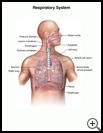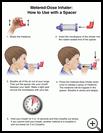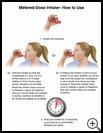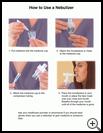
Chronic Obstructive Pulmonary Disease (COPD) Discharge Information
What is chronic obstructive pulmonary disease?
Small tubes called airways carry air in and out of your lungs. The airways branch into smaller and smaller tubes. At the end of each airway is a small sac that fills with air. The oxygen that you breathe in is transferred to your bloodstream through these air sacs. In healthy lungs, the airways are open and clear. The small sacs easily stretch like a balloon when you breathe in, and return to their smaller size when you breathe out.
Chronic Obstructive Pulmonary Disease (COPD) is a serious lung disease. Chronic means that the condition is life-long. Obstructive means that the airways are blocked by weakened or damaged lung tissue. Pulmonary refers to your lungs. There are two types of COPD:
- Chronic bronchitis: The muscles around the airways tighten up. Swelling, irritation, and sticky mucus block the airways, which makes it hard for you to breathe. This type of COPD causes mucous and coughing.
- Emphysema: Some of the air sacs in your lungs are destroyed, or they lose their ability to get bigger and smaller as air moves in and out. This makes it harder for your lungs to get oxygen into your blood. This type of COPD causes wheezing and shortness of breath.
Some people have both chronic bronchitis and emphysema.
COPD is usually caused by many years of smoking. Other possible causes are breathing in lots of secondhand smoke, air pollution, chemical fumes, or dust from your job, untreated asthma, and frequent lung infections. Some people have an inherited condition, called alpha tripsin deficiency, which can cause COPD.
How can I take care of myself when I go home?
COPD cannot be cured. Once you have COPD, it may improve with treatment, but your lungs will not be entirely normal. Taking good care of yourself can keep it from getting worse. The goals of COPD treatment are to:
- Relieve symptoms to help you breathe better and feel better
- Help you be more physically active
- Treat infections when they happen
- Help prevent complications
- Help prevent the condition from getting worse
Management
- Your provider will give you a list of your medicines when you leave the hospital.
- Know your medicines. Know what they look like, how much you should take each time, how often you should take them, and why you take each one.
- Take your medicines exactly as your provider tells you to.
- Carry a list of your medicines in your wallet or purse. Include any nonprescription medicines and supplements on the list.
- Talk to your provider before you use any other medicines, including nonprescription medicines.
- Your provider may prescribe medicine to:
- Relax and open the airways
- Reduce swelling in your lungs
- Loosen the mucus in your lungs and help you cough it up
- Treat or prevent an infection
- Make breathing easier
- You may need to use oxygen at home for part of the day or all day or night.
- Your provider may recommend other types of therapy to help relieve pain, other symptoms, or side effects of treatment.
Appointments
- Follow your provider's instructions for follow-up appointments.
- Keep appointments for any testing you may need.
- Talk with your provider about any questions or concerns you have.
Diet, Exercise, and Other Lifestyle Changes
- Don't smoke. Smoking can worsen lung disease.
- Follow the treatment plan your healthcare provider prescribes.
- Drink enough fluids to keep your urine light yellow in color, unless you are told to limit fluids.
- Avoid secondhand smoke, air pollution, and extreme changes in temperature and humidity.
- Ask about getting flu and pneumonia vaccinations to help prevent lung infections.
- Avoid close contact with people who have colds or the flu.
- If you plan to travel, discuss your plans with your healthcare provider.
- You may need to continue a rehabilitation program after you leave the hospital to help you adjust to life with COPD. A pulmonary rehabilitation program can help you learn how to live and feel better with COPD. The program will give you information about exercise and a healthy diet. It can help you learn how your lungs work and how to care for your COPD.
- Take care of your health. Try to get at least 7 to 9 hours of sleep each night. Eat a healthy diet and try to keep a healthy weight. If you want to drink alcohol, ask your healthcare provider how much is safe for you to drink. Learn ways to manage stress. Exercise according to your healthcare provider's instructions.
Call emergency medical services or 911 if you have new or worsening:
- Trouble talking or walking because of shortness of breath
- Bluish or gray color of your lips or fingernails
- Trouble breathing that does not get easier with medicine
- Fast breathing or trouble catching your breath
- Feeling like you are going to die
- Chest discomfort (pressure, fullness, squeezing or pain) that lasts more than a few minutes or goes away and comes back or chest discomfort that goes to your arms, neck, jaw or back
If you have any of these symptoms, do not drive yourself.
Call your healthcare provider if you have new or worsening:
- Chest pain when you take a breath
- Fever higher than 101.5° F (38.6° C)
- Coughing up mucus that is thick or blood-stained
- Shortness of breath
Ask your healthcare provider about any medicine, treatment, or information that you do not understand.
Last modified: 2016-04-19
Last reviewed: 2016-04-19




